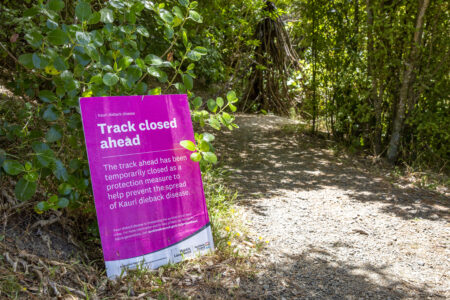
More than $100,000 will be spent to tackle an incurable tree disease that’s kept a popular east Auckland walking track closed for more than two years.
An Auckland Council spokesperson says just a single track in the Howick ward requires mitigation works to protect against kauri dieback.
Dieback, which has no known cure, is a fungus-like organism that infects a tree through its roots.
It can spread via people’s shoes or by dogs and other animals and kills most trees it infects.
The local track closed due to dieback is along the northern area of Point View Reserve in East Tamaki Heights.
It was closed in September 2019 with temporary fencing installed later that year to restrict access to specific areas.
“A tender has been let and the mitigation works are expected to commence in late February, subject to any disruptions caused by Covid or delays in the delivery of supplies,” the spokesperson says.
“It should be completed by mid-April, subject to Covid restrictions and supply of materials.
“There are several solo kauri trees in the reserve which will receive some fencing to restrict access to the ground around the trees.
“The works are expected to cost around $120,000, to be funded by the Natural Environment Targeted Rate and should take between four-five weeks to complete.”
The work includes track improvements to meet Ministry for Primary Industries (MPI) standards for kauri tracks, the spokesperson says.
“The works will provide the tracks with a dry surface with new aggregate surfacing, geo web fabric to hold surface material in place, side drains to collect and prevent water flow over the track, culverts and small boardwalks over depressions.”
Howick Local Board chairperson Adele White says: “We must do all we can to protect our iconic kauri trees.
“People will help prevent disease by staying away from closed tracks.
“When visiting areas with healthy kauri trees it’s essential to clean footwear, tyres and equipment before and after entering the area.
“This includes a dog’s paws too.
“Some of our larger parks provide cleaning stations and signs to guide people.”
The council is taking a range of actions to address the risk of kauri dieback across the city.
Numerous forested areas and tracks around the region have been closed to protect healthy and at-risk kauri.
The main impacted areas are in the Waitakere and Hunua Ranges and other parts of the Franklin Local Board area, some tracks in the Kaipatiki Local Board area on the North Shore and a few tracks on Waiheke Island.
The Government allocated $28 million, as part of $32 million invested over five years, in last year’s Budget to roll out a National Pest Management Plan to protect kauri from dieback.
Associate Environment Minister James Shaw said at the time: “Our kauri forests are an incredibly important taonga (treasure) … and our Government is taking action to ensure they remain standing, healthy, and strong.
“Right now these iconic trees face potentially fatal threats from kauri dieback.
“Stopping the spread of the disease needs increased support and resources and this Government is providing that.”
MPI says kauri trees can be infected with dieback for a long time before they show signs of the disease and most, if not all, will die once infected.









